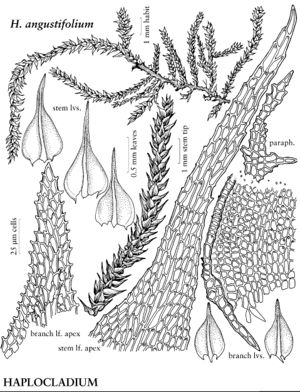Haplocladium
Hedwigia 38: 149. 1899.
| Taxon | Illustrator ⠉ | |
|---|---|---|
 | Haplocladium angustifolium | Patricia M. Eckel |
Plants small to medium-sized, in dense mats, olive green, yellow-green, or brownish. Stems pinnate to subpinnate; paraphyllia few or many, filamentous to subfoliose, cells papillose; rhizoids often arising from axils of older leaves. Stem and branch leaves dimorphic. Stem-leaves erect, curved, or subsecund when dry, erect-spreading when moist, ovate to sometimes triangular, plicate or not; margins plane to somewhat recurved basally, weakly serrulate to serrulate, limbidium absent; apex abruptly short or long-acuminate, hairpoint absent; costa single, ending in apex or subpercurrent, opaque, weakly flexuose distally; alar cells little differentiated to quadrate; medial laminal cells rectangular to rhomboidal, smooth, 1-papillose over lumen, or prorulose at distal end, walls thin to firm, rarely incrassate. Branch leaves smaller; margins more strongly serrate; laminal cells more strongly papillose. Specialized asexual reproduction absent. Sexual condition autoicous; perichaetial leaves pale, erect, longer, apex narrowly long-acuminate. Seta 1.5–3 cm. Capsule erect, inclined, or horizontal, oblong, curved; annulus present; operculum conic, short-rostrate; peristome perfect; exostome teeth lanceolate, densely cross striate-papillose proximally, papillose distally; endostome basal membrane high, segments broad, cilia well developed. Spores 8–14 µm, granulate to nearly smooth.
Distribution
Nearly worldwide except Antarctica
Discussion
Species 17 (3 in the flora).
Haplocladium occurs on rock, humus, wood, and soil in open woodland habitats. The genus resembles Thuidium (Chryso-hypnum) but is only 1-pinnate, has fewer paraphyllia, and the apical laminal cell has a single papilla at the tip. The paraphyllia are filamentous; the proximal laminal cells are papillose and the distal cells usually smooth; the seta is smooth and frequently flexuose; the capsules are strongly contracted below the mouth when dry; and the endostome has nodose cilia in groups of two or three.
Selected References
None.
Key
| 1 | Stem leaves 2-plicate basally; paraphyllia filamentous, infrequently branched; branch leaves somewhat distant. | Haplocladium microphyllum |
| 1 | Stem leaves not plicate; paraphyllia filamentous to subfoliose, frequently branched; branch leaves crowded | > 2 |
| 2 | Stems regularly pinnate; branch leaves oval; apices acute to apiculate; laminal cell papillae over lumen. | Haplocladium virginianum |
| 2 | Stems irregularly pinnate; branch leaves oval to ovate; apices acuminate; laminal cell papillae shifted distally. | Haplocladium angustifolium |
"broad" is not a number.